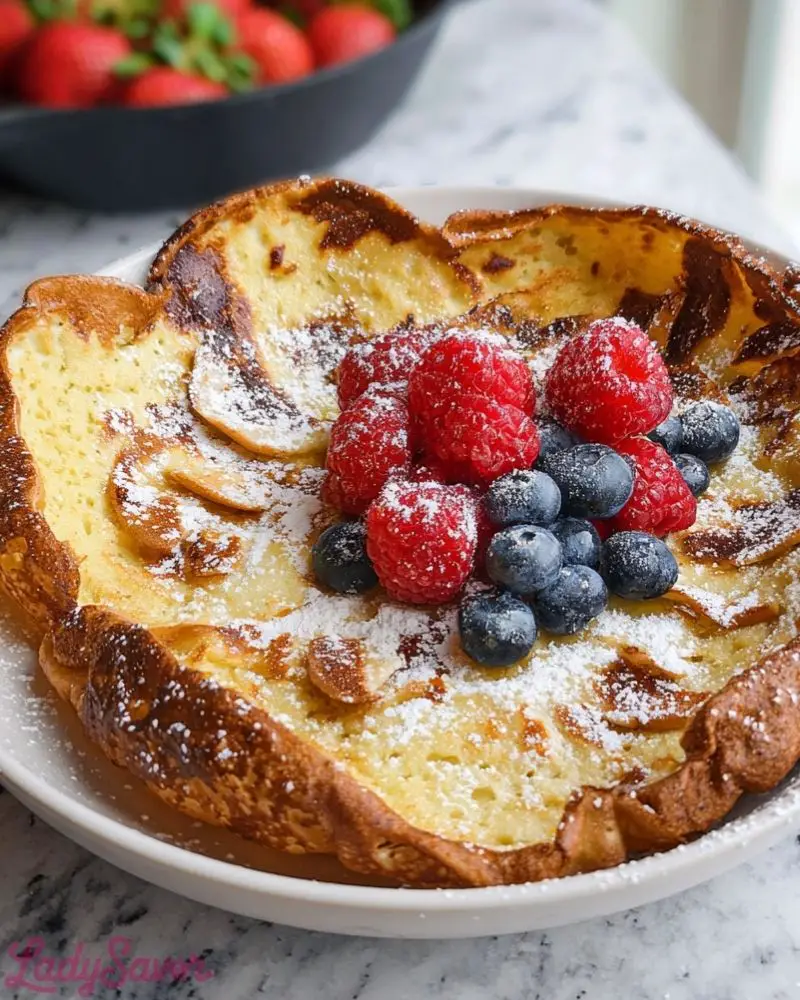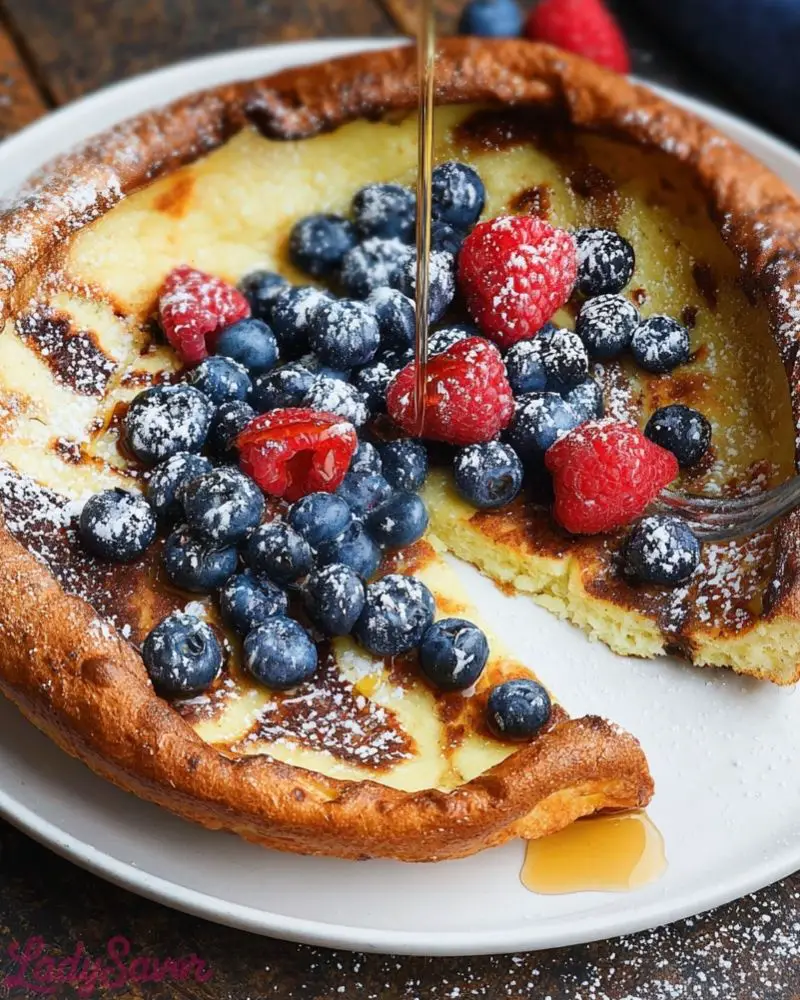I remember the first time I pulled a German Pancake out of the oven—it puffed up like magic, golden and crisp around the edges with a soft, custard-like center. It looked impressive and dramatic, yet it came together with just a few ingredients I already had in my pantry. That contrast—between how simple it is to make and how stunning it looks—immediately won me over. Since then, it’s become my go-to recipe for lazy weekend brunches and holiday mornings alike.

What I love most about this German Pancake is how adaptable it is. You can keep it classic with just a dusting of powdered sugar and a squeeze of lemon, or load it up with fresh berries, warm maple syrup, or even spiced apples in fall. It’s not just breakfast—it’s a little moment of joy pulled hot from the oven.
Why You’ll Love This German Pancake
- It’s almost effortless – The blender (or just a whisk) does all the work.
- It’s fast – From start to finish, you’ll have it on the table in under 30 minutes.
- It’s beautiful – Those puffed-up edges are guaranteed to impress.
- It’s versatile – Dress it up sweet or savory, depending on your mood or the season.
- It’s made with kitchen staples – No special trips to the grocery store required.
What Kind of Pan Should I Use for a German Pancake?
A cast iron skillet is the gold standard when it comes to making a German Pancake. Its ability to retain heat helps the batter puff up dramatically and cook evenly. A 10- or 12-inch skillet is perfect for a single large pancake. If you don’t have cast iron, any oven-safe baking dish or metal pan with similar dimensions will work. Just make sure it’s preheated thoroughly in the oven—this is what gives the pancake that signature lift.
Options for Substitutions
Even though this recipe is beautifully simple, there’s room to get creative if needed:
- Milk – Any milk will work, including dairy-free options like almond, oat, or soy milk. Whole milk gives the richest result.
- Flour – All-purpose flour is classic, but you can swap in a 1:1 gluten-free blend if needed. I wouldn’t recommend using nut flours, as they’ll affect the puff.
- Butter – Unsalted butter is best, but if you use salted, just skip adding any extra salt to the batter.
- Eggs – This recipe relies heavily on eggs for structure and lift, so unfortunately, egg substitutes don’t perform well here.
- Toppings – No fresh berries? Try sliced bananas, sautéed apples, or a drizzle of honey and a handful of nuts.
Ingredients for This German Pancake
- Eggs – The backbone of the recipe, eggs give the pancake its structure, richness, and signature puff. You’ll need three large ones.
- Milk – Adds moisture and helps the batter stay smooth and pourable. Whole milk gives the best flavor and texture.
- All-Purpose Flour – Just a modest amount of flour creates the light, custardy base that crisps beautifully at the edges.
- Vanilla Extract – A splash of vanilla gives warmth and depth to the flavor.
- Salt – Just a pinch to balance the sweetness and enhance the overall taste.
- Butter – Melted in the hot pan, butter prevents sticking and adds a rich, golden crust to the pancake.
- Powdered Sugar – A light dusting at the end adds a sweet, delicate finish.
- Fresh Berries – Optional, but they bring color, freshness, and a tart contrast to the soft pancake.

Step 1: Preheat Your Oven and Pan
Start by preheating your oven to 425°F (220°C). Place your cast iron skillet or oven-safe pan inside the oven while it heats. This ensures your pan is piping hot when the batter hits it—essential for that dramatic puff.
Step 2: Make the Batter
In a blender (or using a bowl and whisk), combine 3 large eggs, ½ cup of all-purpose flour, ½ cup of milk, 1 teaspoon of vanilla extract, and a pinch of salt. Blend until smooth and frothy. Let the batter rest for 5 minutes while the oven finishes heating.
Step 3: Add Butter to the Hot Pan
Once the oven is fully preheated, carefully remove the hot pan and add 2 tablespoons of unsalted butter. Swirl it around to coat the bottom and sides. Be quick—this step is all about keeping the pan hot!
Step 4: Pour in the Batter
Immediately pour the batter into the buttery pan and return it to the oven. No stirring, no touching—just let the magic happen.
Step 5: Bake Until Puff and Golden
Bake for 18–22 minutes, or until the edges are puffed and deeply golden brown. Avoid opening the oven door early, or you’ll risk deflating your pancake.
Step 6: Serve Fresh and Hot
Remove from the oven and top with a dusting of powdered sugar. Add fresh berries, a drizzle of maple syrup, or a squeeze of lemon juice—whatever suits your morning mood.
How Long to Cook the German Pancake
The German Pancake typically takes 18 to 22 minutes to bake in a preheated 425°F (220°C) oven. You’ll know it’s ready when the edges are deeply golden and dramatically puffed, and the center is set but slightly custardy. It will deflate a bit once out of the oven—totally normal and part of its rustic charm.
Tips for Perfect German Pancake
- Use a Hot Pan – Preheating the pan in the oven is crucial. It helps the batter sizzle on contact and puff up beautifully.
- Don’t Overmix the Batter – Blend or whisk just until smooth. Overmixing can make the pancake dense instead of airy.
- Room Temperature Eggs and Milk – This helps the batter blend evenly and rise better in the oven.
- Serve Immediately – A German Pancake is at its absolute best straight out of the oven. The texture and visual appeal fade quickly, so have your toppings ready.
- Avoid Peeking – Opening the oven too early can cause the pancake to collapse. Keep the door shut until the baking time is nearly up.
Watch Out for These Mistakes While Cooking
- Skipping the Pan Preheat – If your pan isn’t hot enough when you pour in the batter, the pancake won’t rise properly and might cook unevenly.
- Overfilling the Pan – Stick to the batter measurements. Too much batter can spill over or bake unevenly.
- Using Cold Ingredients – Cold eggs and milk can result in a denser pancake. Let them come to room temperature first.
- Opening the Oven Door – The heat drop can deflate the pancake before it’s fully set.
- Not Serving Immediately – The pancake will lose its puff and become chewy if it sits too long. Serve it the moment it comes out of the oven.
What to Serve With German Pancake?
Fresh Berries and Whipped Cream
Sweet and tart berries pair perfectly with the custardy pancake and add freshness.
Maple Syrup or Honey
A classic drizzle of sweetness that soaks into every bite.
Lemon Juice and Powdered Sugar
A simple but bright combo that balances richness with a tangy finish.
Sautéed Apples with Cinnamon
Warm spiced apples give cozy, autumnal vibes and a beautiful contrast in texture.
Crispy Bacon or Breakfast Sausage
If you like a savory-sweet mix, this pairing adds protein and a salty crunch.
Greek Yogurt or Crème Fraîche
Add a dollop for creaminess and a slight tang to balance the flavors.
Toasted Nuts or Granola
A bit of crunch takes the pancake to another level, especially with fruit on top.
Storage Instructions
If you happen to have leftovers (though that’s rare in my house), store slices of the German Pancake in an airtight container in the refrigerator for up to 2 days. To reheat, pop it in a 350°F (175°C) oven for about 5–8 minutes, or until warmed through. The texture won’t be as airy as fresh, but it still tastes great. I don’t recommend freezing it—the delicate, puffy texture doesn’t survive well.
Estimated Nutrition (Per Serving, based on 4 servings)
- Calories: 210
- Total Fat: 11g
- Saturated Fat: 6g
- Cholesterol: 140mg
- Sodium: 115mg
- Total Carbohydrates: 21g
- Fiber: 0.5g
- Sugars: 4g
- Protein: 8g
Note: These values will vary based on toppings and any ingredient substitutions.
Frequently Asked Questions
How do I make the pancake puff up more?
Make sure your oven and pan are fully preheated. Also, avoid opening the oven door while it’s baking. Cold batter into a hot pan is key to maximum puff.
Can I use a blender to mix the batter?
Yes! A blender is ideal for making a smooth, lump-free batter and even gives a little extra aeration. But a whisk works fine too.
What if I don’t have a cast iron skillet?
You can use any oven-safe dish or metal pan, around 10–12 inches wide. Just be sure to preheat it in the oven with the butter as you would with cast iron.
Can I make it savory?
Definitely! Skip the vanilla and powdered sugar, and try adding herbs, cheese, or sautéed veggies. Serve with a dollop of crème fraîche or sour cream.
Why did my pancake deflate?
It’s supposed to! The pancake puffs up dramatically in the oven and then naturally deflates a bit once removed—this is completely normal.
Can I double the recipe?
You can, but it’s better to bake two separate pancakes in two pans rather than overfilling one. This ensures even cooking and puff.
What’s the best way to serve it?
Right out of the oven with your toppings ready. Slice it into wedges and serve like a pie, while it’s still warm and puffy.
Is this the same as a Dutch baby?
Yes! “German Pancake” and “Dutch Baby” are two names for the same dish. It’s believed to have originated in German-American communities.
Conclusion
German Pancakes are one of those magical recipes that feel fancy but come together with almost no effort. With a few pantry staples, a hot pan, and a little bit of patience, you’re rewarded with a dish that’s light, golden, and endlessly customizable. Whether you enjoy it sweet or savory, for breakfast or dessert, it’s sure to become a staple in your kitchen too.

German Pancake
- Total Time: 30 mins
- Yield: 4 servings 1x
- Diet: Vegetarian
Description
This German Pancake is a golden, puffed-up breakfast delight with crispy edges and a soft, custardy center. Made with simple pantry staples, it’s quick, versatile, and perfect for brunch or a cozy morning treat. Serve it sweet or savory—either way, it’s a guaranteed showstopper.
Ingredients
3 large eggs
1/2 cup milk
1/2 cup all-purpose flour
1 teaspoon vanilla extract
1 pinch salt
2 tablespoons unsalted butter
1 tablespoon powdered sugar (for topping)
1/2 cup fresh berries (optional)
Instructions
1. Preheat your oven to 425°F (220°C). Place a 10- or 12-inch cast iron skillet in the oven to heat.
2. In a blender or bowl, combine eggs, flour, milk, vanilla, and salt. Blend or whisk until smooth.
3. Let the batter rest for 5 minutes.
4. Carefully remove the hot skillet and add butter. Swirl to coat the bottom and sides.
5. Pour the batter into the hot, buttery skillet.
6. Bake for 18–22 minutes, until puffed and golden brown.
7. Remove from oven, top with powdered sugar and berries if desired.
8. Serve immediately while still warm and puffed.
Notes
For best results, use room temperature ingredients.
Avoid opening the oven door during baking to maintain rise.
This pancake is best enjoyed fresh but can be stored for up to 2 days in the refrigerator and reheated.
- Prep Time: 10 mins
- Cook Time: 20 mins
- Category: Breakfast
- Method: Baking
- Cuisine: German-American
Nutrition
- Serving Size: 1 slice
- Calories: 210
- Sugar: 4g
- Sodium: 115mg
- Fat: 11g
- Saturated Fat: 6g
- Unsaturated Fat: 4g
- Trans Fat: 0g
- Carbohydrates: 21g
- Fiber: 0.5g
- Protein: 8g
- Cholesterol: 140mg

